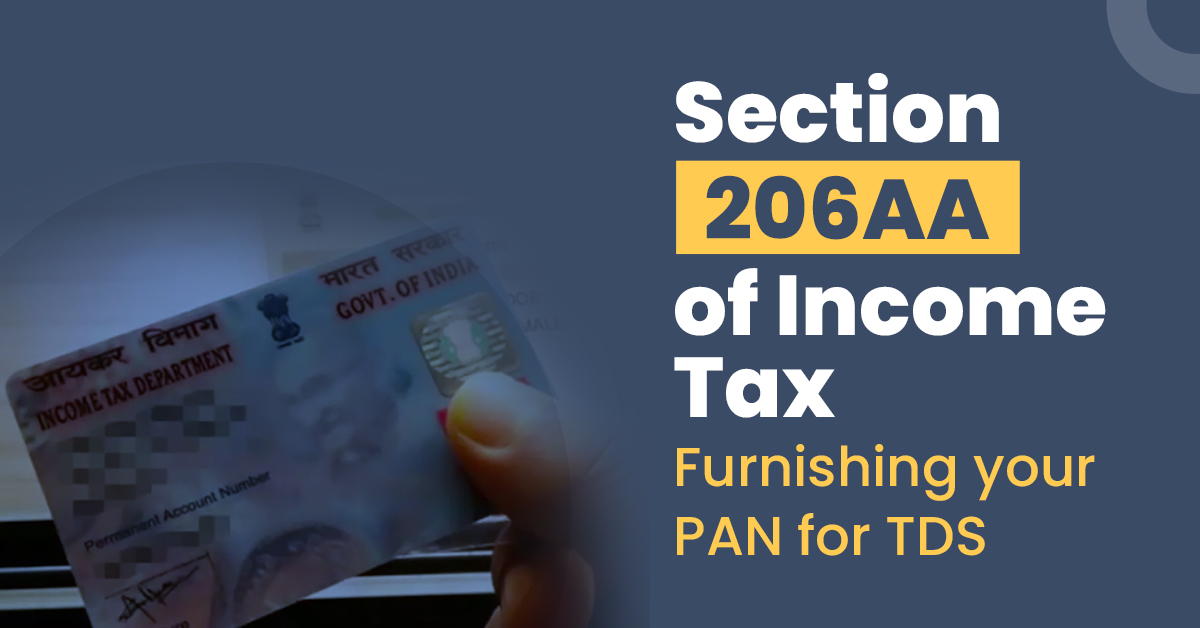Section 206AA Of The Income Tax: Furnishing Your PAN For TDS


Many payments or transactions between two taxpayers include the deduction of TDS at the appropriate rate under several provisions. The threshold limit and criteria are also prescribed in every relevant TDS rate provision. The most important criterion specified by the Income Tax Act of 1961 is that the payer provides his or her PAN. This is because the payer will be subject to a greater tax rate if the recipient does not have a PAN.
Furthermore, the TDS deduction will not be shown in the payee’s name or on his/her Form 26AS. Simply by failing to include the PAN, the payee causes problems for all involved, the payee, the payer and the Income Tax Department. This is why Section 206AA of the Income Tax Act of 1961 has stringent restrictions requiring the payee to cite their PAN to the income recipient.
What Is Section 206AA Of The Income Tax Act?
Any taxpayer entitled to receive any TDS-eligible amount must provide his or her PAN to the taxpayer liable for paying that amount. Any failure to quote their PAN will result in a higher percentage of TDS deduction. Section 206AA applies to both resident and non-resident taxpayers.
Exception Under Section 206AA
The rates differ if the payer pays any amount covered by sections 194O and 194Q. Section 194O allows TDS to be deducted from payments to an E-commerce participant. Section 194Q allows for the deduction of tax at source when a particular amount is paid for the acquisition of goods. As a result, the one of following rates (whichever is higher) shall apply:
- At a 5% annual rate; or.
- At the rate prescribed in the applicable section of this Act
TDS Rate Under Section 206AA
If the payee does not provide the payer with their PAN, the payer will deduct tax at the rates shown below:
- At a 20% annual rate; or
- At the rate prescribed in the applicable section of this Act
Mrs Neha, for example, is obligated to pay ₹1,00,000 to Mrs Priya as professional fees under Section 194J. Mrs Priya (payee) fails to provide Mrs Neha with her PAN (payer). Section 206AA applies here. Section 194J allows for a 10% TDS deduction. However, since Section 206AA applies, the TDS rate will be 20%. Mrs Neha would withhold ₹20,000 as TDS.
Section 206AA – Applicability Of Lower Tax Deduction
Section 197 allows for a lesser or zero TDS deduction. A taxpayer may apply under Section 197 for a reduced or zero TDS deduction. The assessing officer provides a certificate authorising the deduction of TDS at defined rates for a certain period. Section 206AA states that the certificate issued under section 197 is void if the taxpayer fails to include the PAN while applying. If the certificate becomes invalid owing to an inaccurate PAN or lack of validity, section 206AA and standard TDS rates will apply. In such a circumstance, a reduced or zero TDS deduction is no advantage.
Non-Applicability Of Section 206AA
The Income Tax Act of 1961, Section 206AA, does not apply to two categories of transactions. To begin with, it does not apply to interest income paid to a non-resident taxpayer on long-term bonds covered under section 194LC.
In addition, it does not apply to any royalties, interest, fees for technical services, or payments made on the transfer of any kind of capital asset. This payment is made to a non-corporate non-resident or a foreign business that does not have a PAN. On the other hand, the payee taxpayer must furnish the payer with the following information. These requirements are outlined in Rule 37BC, which was subsequently included as a result of Notification No. 53/2016.
- The full address of the nation or region in which he or she resides.
- The payee must supply the payer with their name, contact details, and email address.
- The payee’s tax identification number is issued by the nation or territory in which he or she resides. Suppose the tax identification number is not accessible. In that case, the payee must supply the identity information used as tax identification in the nation or territory where he or she resides.
- If the nation or territory legislation requires a residential certificate, the payee must present one to confirm his or her residence status.
Things To Keep In Mind
- If the taxpayer submits an inaccurate PAN, it will be assumed that the taxpayer has failed to supply their PAN. In this instance, the requirements of Section 206AA will apply.
- Forms 15G and 15H are invalid unless the taxpayer provides their PAN. Section 206AA applies if there is no PAN or if the PAN is inaccurate.
- Both the payer and the payee are required to provide their PAN. They must include it in all bills, vouchers, and other papers that establish their work relationship.
Wrapping Up
Thus, Section 206AA of the Income Tax Act requires you to provide your PAN if you receive payments subject to TDS. You will be charged a higher TDS rate if you do not provide your PAN. This section applies to both native and non-native Indians.
Frequently Asked Questions (FAQs)
Does Section 206AA supersede DTAA?
No, section 206AA does not supersede the DTAA as defined in section 92 of the Income Tax Act of 1961.
Is there a cess on 206AA?
No, there is no cess on section 206AA. This is because the cess does not apply to tax deducted at source. TDS is levied at a fixed rate. As a result, neither a cess nor a fee is applicable.
What is the purpose of Form 26AS?
Form 26AS is an annual statement containing information on advance tax, TDS collected, self-assessment tax, tax refunds, etc. Your tax credit statement allows you to determine if a deductor appropriately filled out TDS or TCS (Tax collected at source) statements. When completing an ITR, you may also examine and verify tax credits and income tax. You may also find out whether the tax deducted on your behalf is properly filed to the government’s account.
How can taxpayers get a certificate for a lower-rate TDS deduction?
Section 197 allows taxpayers whose income is subject to TDS to apply for lesser deductions. You must submit Form No. 13 to the Assessing Officer (AO) having authority over your house. Log in to the TRACES portal and choose ‘Request for Form 13’ to access this form.
How can taxpayers get a certificate for a lower-rate TDS deduction?
Section 197 allows taxpayers whose income is subject to TDS to apply for lesser deductions. You must submit Form No. 13 to the Assessing Officer (AO) having authority over your house. Log in to the TRACES portal and choose ‘Request for Form 13’ to access this form.
What is the difference between Sections 206AA and 206AB of the Income Tax Act?
To avoid paying higher tax rates, individuals who are liable for TDS are required under Section 206AA to submit their PAN. Several taxpayers are eligible for higher TDS deduction rates as per Section 206AB. Those with a total tax liability of more than ₹50,000 or who have not filed an ITR for the two assessment years before the current one must incur a higher tax liability.







